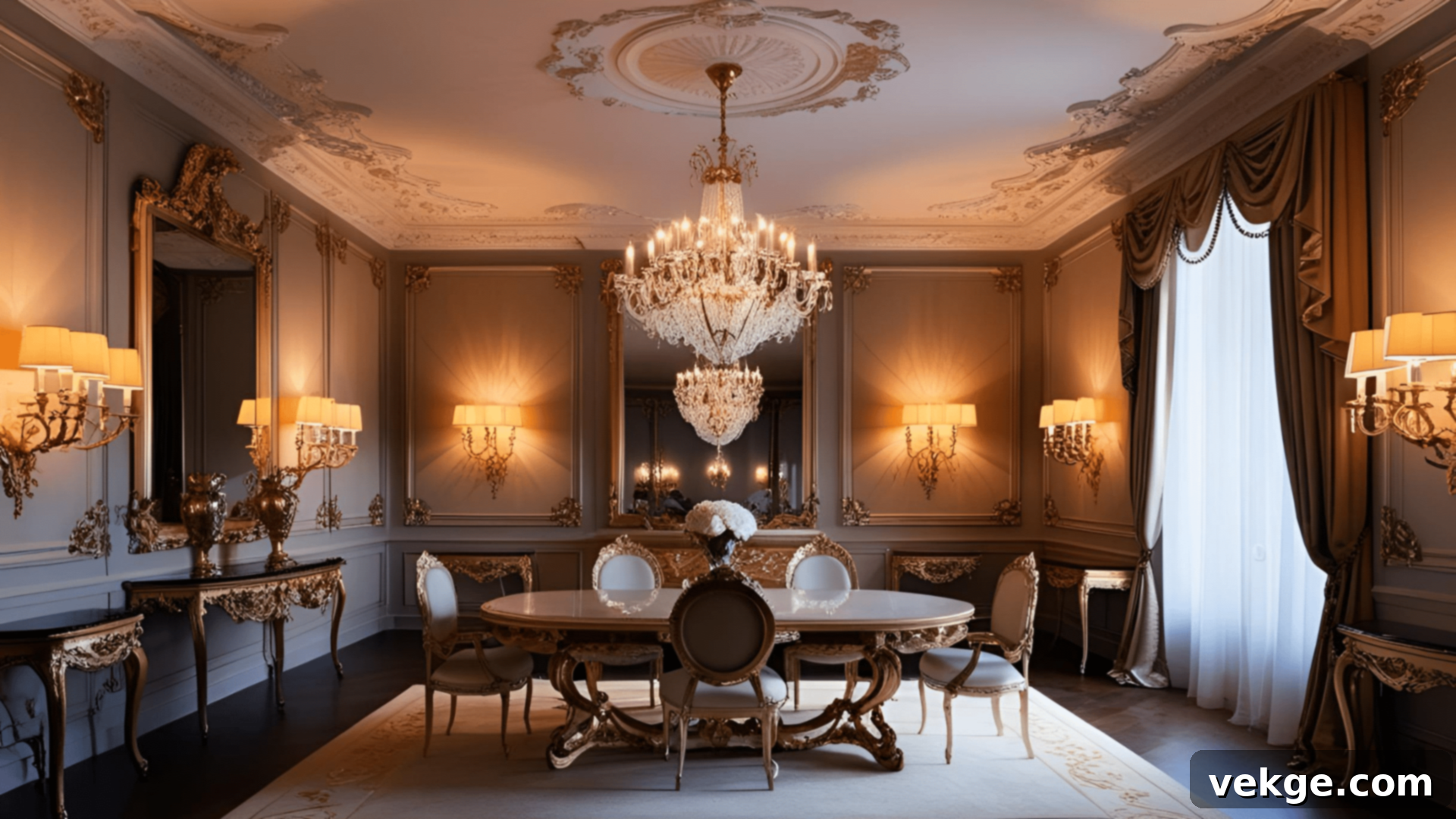Mastering Modern Baroque: A Guide to Blending Opulence with Contemporary Style
Baroque interior design, a style steeped in the grandeur of 17th-century Europe, is experiencing a remarkable resurgence in modern homes. Far from being confined to historical palaces, this opulent aesthetic now finds its place in contemporary living, seamlessly blending rich, intricate details with today’s clean lines and minimalist sensibilities. This unique fusion of old-world luxury and modern comfort offers homeowners an opportunity to create spaces that are both deeply historical and refreshingly current.
Increasingly, designers and homeowners are embracing Baroque touches to craft interiors that exude a unique blend of timeless elegance and modern flair. Imagine grand, statement furniture pieces set against a backdrop of simple, uncluttered walls, or bold, jewel-toned colors mixed with spacious, airy layouts. This captivating interplay of historical depth and modern simplicity proves exceptionally versatile, working beautifully in everything from expansive residential properties to chic, intimate commercial spaces.
In this comprehensive guide, we will delve into the defining characteristics that make Modern Baroque truly special. We’ll explore practical, step-by-step methods to infuse these luxurious elements into your own home, transforming ordinary rooms into extraordinary showcases. Furthermore, we’ll uncover why this thoughtful blend of eras creates visually stunning, eye-catching spaces that not only stand out but also offer a unique narrative in today’s design landscape.
Essential Elements of Modern Baroque Design: Where History Meets Today
Modern Baroque design is a masterful reinterpretation of a classical style, injecting the lavishness of the past with a fresh, contemporary twist. Understanding its core components is key to successfully integrating this look into today’s homes, ensuring the design feels both luxurious and livable.
Opulent Materials: The Foundation of Luxury
At the very heart of authentic Baroque style lies a profound appreciation for rich, tactile materials that evoke a sense of grandeur and exclusivity. Think plush velvet sofas, exquisitely draped silk curtains, and sumptuously textured brocade pillows. These fabrics are not merely decorative; they invite touch and contribute significantly to the overall sensory experience of a room.
In its modern incarnation, we strategically pair these inherently fancy fabrics with simpler, often neutral backgrounds. This deliberate contrast allows a single velvet armchair, for instance, to become a focal point, imbuing an otherwise plain room with an immediate sense of richness and sophistication without overwhelming the space. The warmth and unmistakable sheen of gold accents further elevate this luxury, adding a touch of metallic glow that feels grand yet carefully restrained.
Intricate Details: Subtle Statements of Sophistication
Historically, Baroque was synonymous with complex patterns and meticulous craftsmanship. Furniture often featured elaborate carvings depicting natural motifs like acanthus leaves, graceful scrolls, and cherubic figures, all adding character to both individual pieces and architectural elements.
The modern approach to these intricate details is one of considered restraint. We’ve found that incorporating just one or two carefully selected pieces with these characteristic Baroque carvings or embellishments can make a dramatic impact without creating a cluttered or overly busy aesthetic. Modern Baroque thoughtfully retains these decorative flourishes but masterfully pairs them with clean, simple spaces. This balance prevents the design from appearing too museum-like or overwhelming, ensuring that each detailed piece is celebrated rather than lost in a sea of ornamentation.
Step-by-Step Guide to Achieving a Modern Baroque Look in Your Home
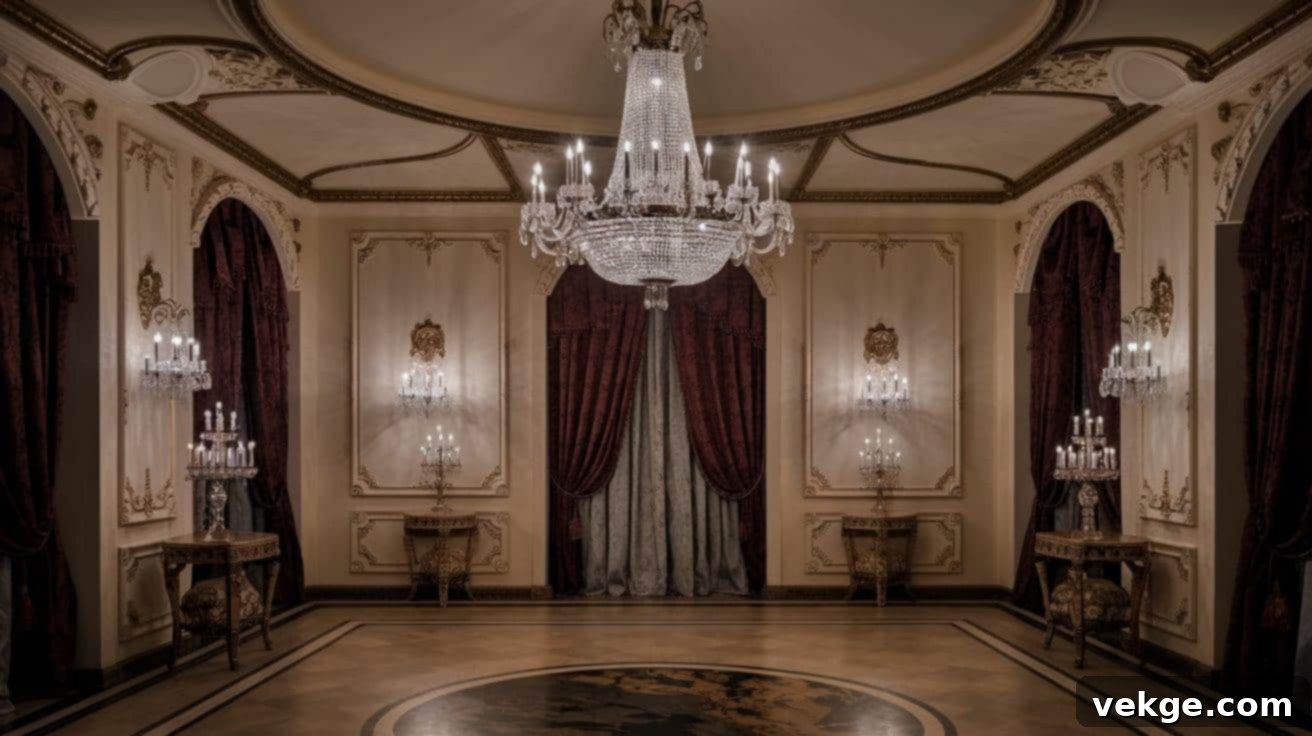
Transforming your home with a Modern Baroque aesthetic doesn’t require living in a palatial estate. This style is accessible and can be integrated into various home types with a thoughtful, step-by-step approach. Here’s how to introduce these luxurious touches into everyday living spaces, one element at a time.
1. Start with a Bold Color Base for Dramatic Impact
Begin by establishing a strong, foundational color palette that sets the opulent tone. Deep, saturated hues are hallmarks of the Baroque era, making rich reds, sophisticated blues, and lush forest greens excellent choices for your base. Consider painting a single accent wall in a vibrant shade to create instant drama, or anchor your room with a large area rug in one of these commanding colors.
For those preferring a more understated elegance, maintain neutral wall colors such as soft greys or creams, and introduce these bold shades through carefully chosen furniture, prominent artwork, or luxurious textiles. This strategy creates a sophisticated and adaptable background, allowing the more intricate and detailed Baroque elements you introduce later to truly shine and capture attention.
2. Add Luxury Fabrics to Elevate Texture and Comfort
Fabrics play an indispensable role in defining the Baroque sensibility. Seek out materials that are rich in texture and visual appeal. Think about investing in a plush velvet armchair, adorning your sofa with silk throw pillows featuring subtle patterns, or installing heavy, floor-length curtains finished with elegant tassels. The tactile quality of these fabrics is paramount.
The most effective approach involves mixing different textures to create compelling contrast. Imagine pairing the smooth, reflective surface of silk with the rich, woven complexity of brocade. Even a subtle introduction, such as two velvet pillows on your existing sofa, can initiate the transformation towards a Modern Baroque aesthetic without requiring a significant investment. This layering of textures adds depth, warmth, and an undeniable sense of luxury to any room.
3. Choose Large-Scale Furniture as Statement Pieces
Baroque furniture is designed to make a grand statement, characterized by both its imposing size and its elaborate detailing. Instead of furnishing an entire room with ornate pieces, select one or two standout items that command attention. This could be a majestic dining table with a substantial base, or a grand bed featuring a towering, intricately carved headboard.
Look for furniture crafted from dark, rich woods, often featuring delicate carving details or elegantly curved legs that hark back to classical designs. The key here is not to overwhelm your space; rather, a single prominent Baroque piece, thoughtfully integrated with more streamlined, modern furniture, establishes a perfect and intriguing balance. This approach ensures your room feels curated and sophisticated, not cluttered.
4. Bring in the Gold Accents for Warmth and Glamour
Gold details are quintessential to the Baroque style, instantly injecting warmth, light, and a sense of historic opulence. Incorporate gold through decorative elements like ornate picture frames, the refined edges of mirrors, or the elegant bases of lamps. These metallic touches are essential for capturing that characteristic Baroque glow.
Even seemingly minor additions, such as gold drawer pulls on a dresser or a chic gold decorative tray on a coffee table, can significantly contribute to the overall luxurious atmosphere. These luminous elements effectively catch and reflect light, enriching the room with a warm radiance that feels both timeless and sophisticated, without appearing outdated.
5. Install Dramatic Lighting to Set the Mood
Lighting is not merely functional in Modern Baroque spaces; it is instrumental in creating the desired dramatic mood and enhancing the luxurious aesthetic. A crystal chandelier, in particular, makes the most significant impact, instantly becoming a dazzling focal point. For a more contemporary interpretation, choose modern versions of chandeliers that feature cleaner lines while retaining their signature sparkle.
Beyond overhead fixtures, wall sconces are excellent for adding soft, ambient light and decorative touches to plain walls, highlighting architectural features or artwork. For ultimate flexibility and control over the atmosphere, always consider installing dimmer switches for your primary light sources. This allows you to easily adjust the intensity—bright for daily tasks and a softer, more intimate glow for evening relaxation and entertaining.
6. Mix in Modern Pieces for Essential Balance
The true genius of Modern Baroque lies in its balance. The secret to a fresh, inviting space is to thoughtfully intersperse your ornate, historical items with clean, simple, and distinctly contemporary pieces. This creates a dynamic tension that prevents the room from feeling like a museum exhibit.
Consider pairing a lavish, intricately framed mirror with a sleek, minimalist console table. Or, complement a grand, carved bed frame with crisp, unadorned white bedding. This intentional juxtaposition keeps the style vibrant, accessible, and perfectly suited for modern living, ensuring the design is both sophisticated and comfortably functional.
7. Pay Attention to Ceiling and Walls for Architectural Detail
Don’t overlook the often-forgotten fifth wall—the ceiling! Traditional Baroque ceilings were frequently adorned with elaborate designs and frescoes. You can emulate this grandeur with simpler, more contemporary applications like classic crown molding or decorative ceiling medallions around light fixtures. These architectural details add character and a sense of bespoke craftsmanship.
For walls, consider applying picture frame molding to create elegant panels. Painting these moldings the same color as the wall results in a subtle yet sophisticated textural effect, maintaining clean lines while adding a layer of understated Baroque formality. Wallpaper with subtle damask or floral patterns can also introduce depth without overwhelming the space.
8. Finish with Select Art and Mirrors for Refined Flourish
To complete your Modern Baroque space, strategically place large mirrors encased in striking gold frames. These not only amplify light and create the illusion of greater space but also serve as powerful decorative elements. Position them opposite windows or in prominent areas to maximize their impact.
For artwork, opt for larger-scale pieces that feature bold colors and are presented in simple, elegant frames. In this style, one commanding painting often makes a more significant statement than a collection of smaller, disparate pieces. The art should draw the eye and contribute to the room’s sense of drama and refined elegance.
Lighting Techniques to Improve Modern Baroque Interiors
Effective lighting is paramount in Modern Baroque spaces, transcending mere illumination to create atmosphere, highlight architectural features, and bridge the gap between historical grandeur and contemporary comfort. The right fixtures can introduce drama while ensuring the space feels current and inviting rather than dated.
Crystal Chandeliers Reimagined for Today
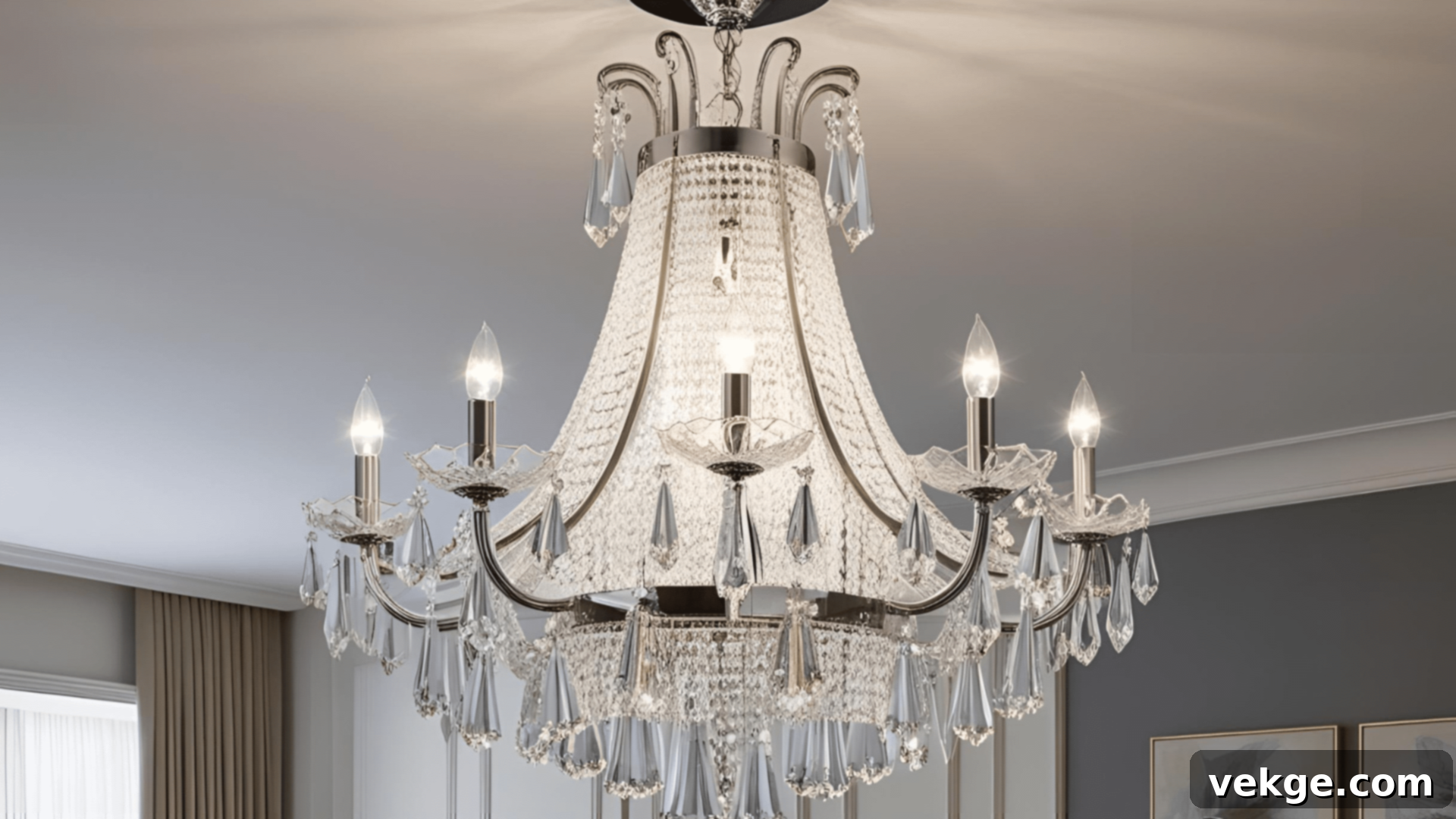
The iconic crystal chandelier, a definitive Baroque lighting element, can be stunning in modern settings when selected judiciously. Contemporary iterations often boast cleaner, more streamlined silhouettes and fewer elaborate dangling components, all while retaining their characteristic sparkle and brilliance. Think of these as sculptural light sources.
Don’t limit their placement to traditional dining rooms. Introducing a crystal fixture into unexpected areas like a lavish bathroom or a sophisticated kitchen can create a delightful contrast. A medium-sized crystal chandelier suspended above a sleek, plain bathtub, for instance, masterfully blends extravagant elegance with modern simplicity, resulting in a truly unique aesthetic.
Layered Lighting Approach for Depth and Ambiance
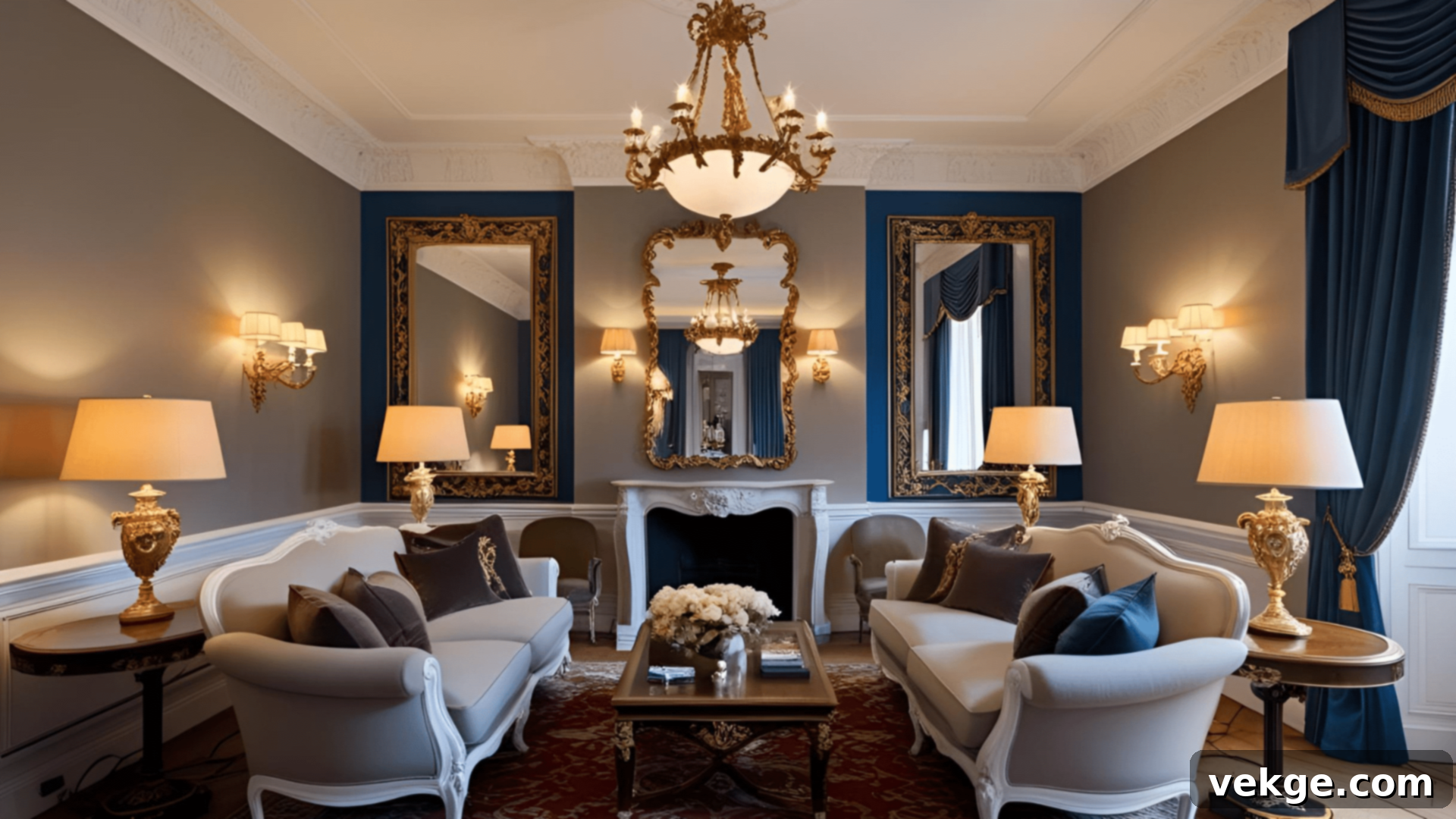
To achieve a nuanced and inviting Modern Baroque interior, a layered lighting approach is essential. This involves combining various light sources at different heights and intensities to create depth, dimension, and dynamic visual interest. Integrate overhead ceiling fixtures with versatile table lamps and elegant wall lights to illuminate the space comprehensively.
This strategic layering serves to highlight intricate Baroque details while simultaneously ensuring the room remains highly functional and adaptable for various activities. In a living room, for example, pairing a smaller, decorative chandelier with discreet wall sconces and complementing them with an ornate table lamp alongside simpler, modern floor lamps creates a harmonious blend of styles and a flexible lighting scheme.
Wall Sconces for Subtle Drama and Accentuation
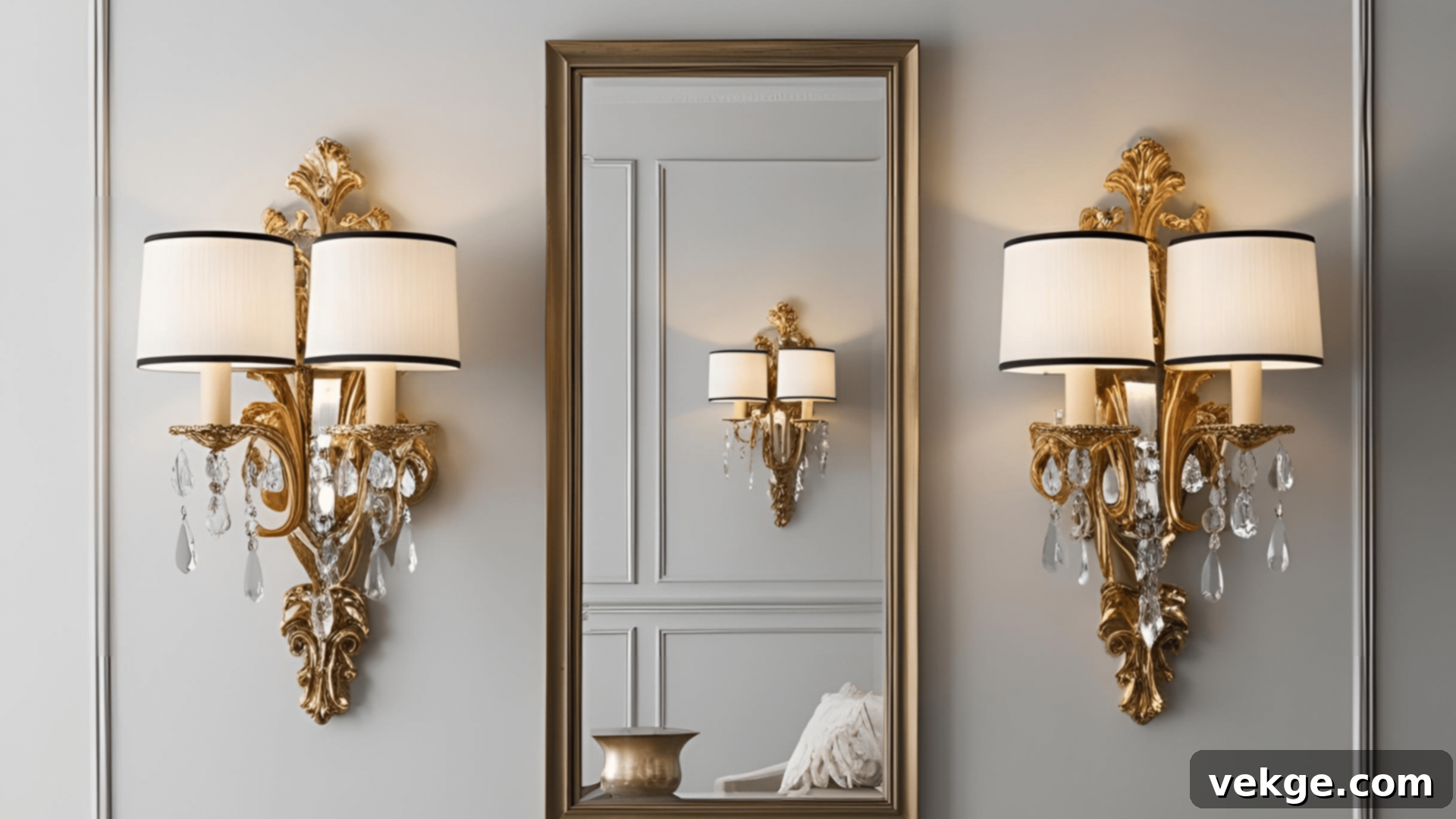
Wall sconces are exceptional for adding that distinctive Baroque flair without consuming valuable floor or table space. Modern versions, often featuring delicate crystal elements or elegant gold details, create perfect accent points against minimalist or subtly textured walls. They offer a sophisticated way to introduce decorative lighting.
Position sconces in symmetrical pairs on either side of a grand mirror, a prominent piece of artwork, or a doorway to establish visual balance and architectural interest. The soft, diffused light emitted by sconces not only enhances the room’s ambiance but also casts a flattering glow, making any space feel more intimate and luxurious.
Modern Spotlights for Targeted Accents
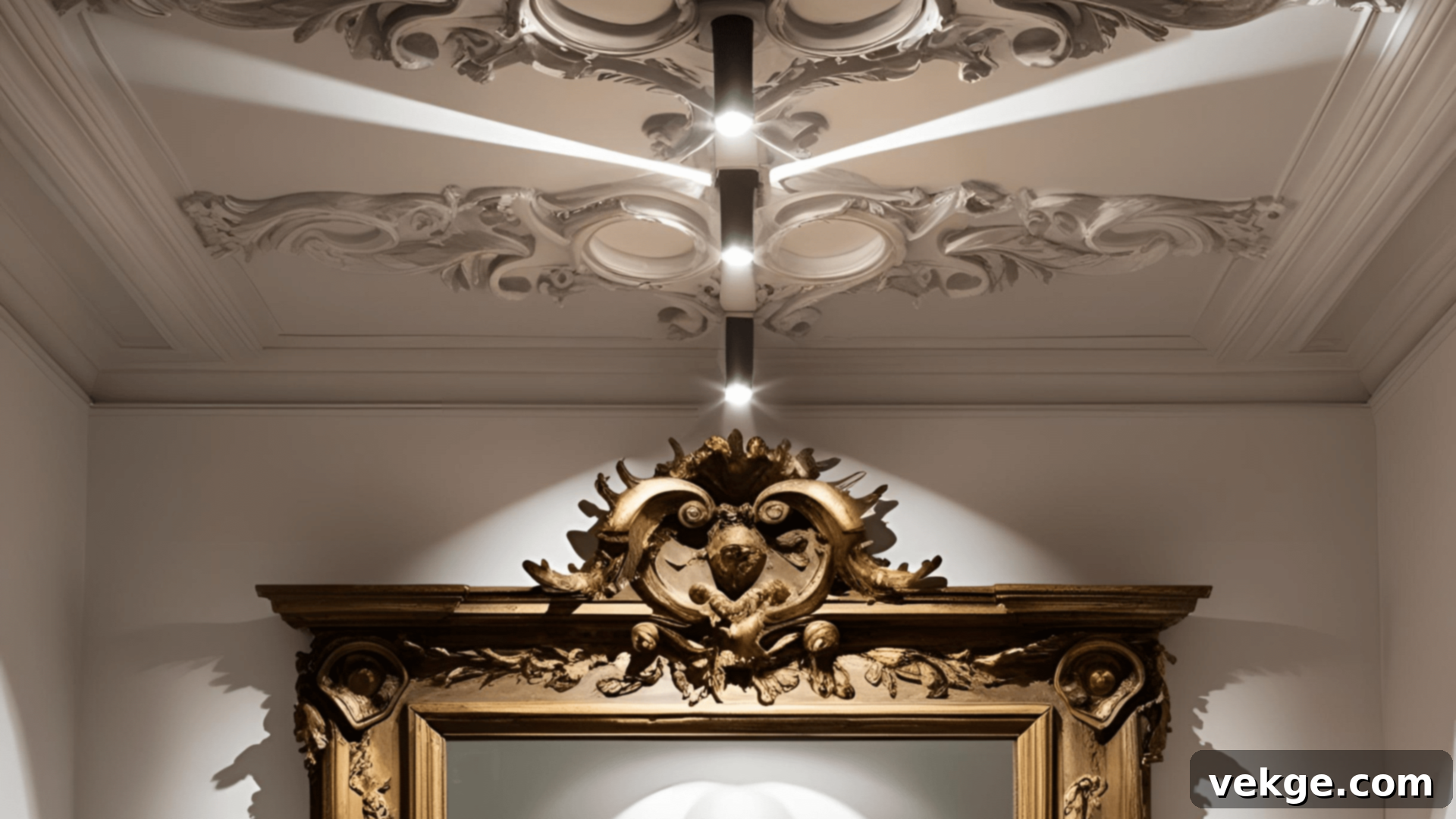
Discreet, contemporary spotlights can be strategically employed to dramatically showcase specific Baroque elements. These hidden lights are perfect for emphasizing the intricate carvings on a picture frame, illuminating a detailed ceiling medallion, or drawing attention to a sculptural object. By creating focused pools of light, they generate captivating shadows and highlights that accentuate the beauty and craftsmanship of complex patterns.
This intelligent application of modern lighting techniques to highlight historical features beautifully illustrates the fusion of old and new, maximizing the visual impact of your most cherished Baroque-inspired pieces.
Light Control Systems for Dynamic Mood Creation
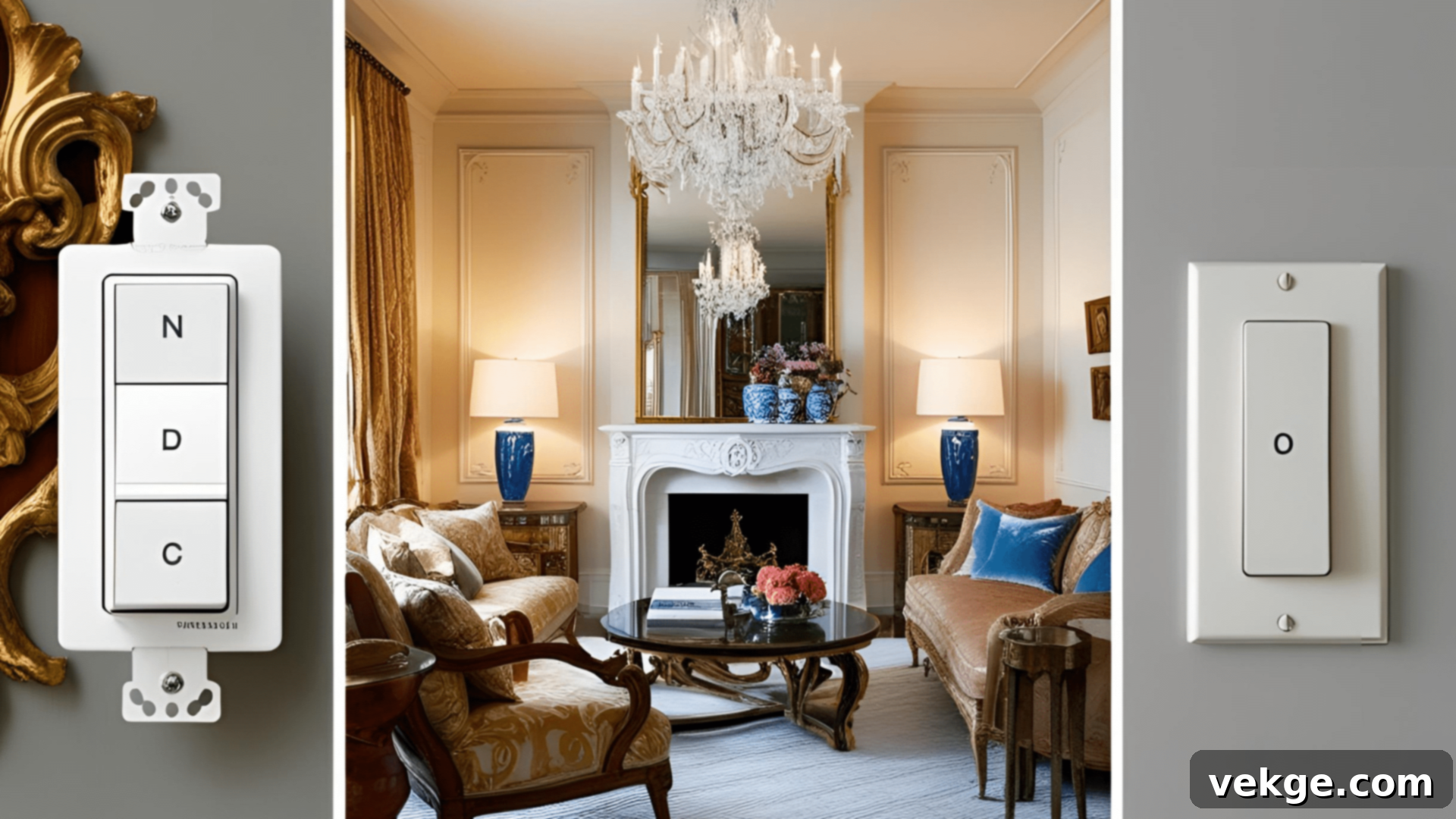
Integrating dimmer switches and comprehensive light control systems is crucial for truly mastering the mood in Modern Baroque interiors. The ability to precisely adjust brightness levels allows your spaces to effortlessly transition between different atmospheres throughout the day and evening. Bright, full illumination reveals every intricate detail and allows for practical tasks, while a lowered, softer light instantly creates an air of evening drama, intimacy, and relaxation.
Installing simple dimmer switches on all main light fixtures is a straightforward yet highly effective enhancement that significantly increases the flexibility and overall luxurious feel of your rooms. It empowers you to curate the perfect ambiance for any occasion.
Balance Through Thoughtful Fixture Selection
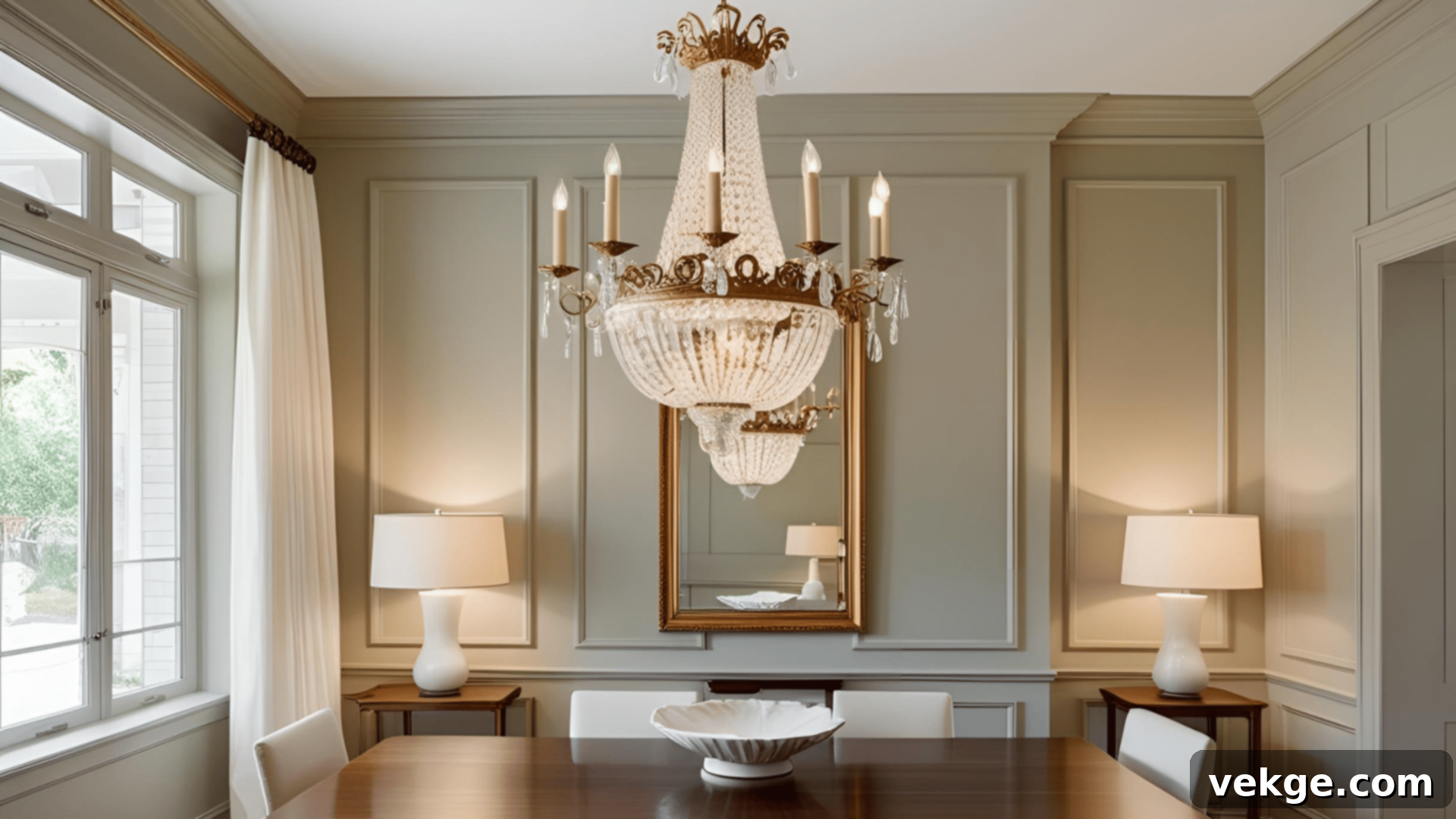
The ultimate key to successful Modern Baroque lighting is achieving a harmonious balance between ornate and simple fixtures within the same space. A grand, elaborate chandelier, for instance, makes its strongest statement when complemented by clean-lined, minimalist table lamps or subtly integrated, hidden architectural lighting. This thoughtful juxtaposition ensures the space feels rich and dramatic without becoming overly heavy, cluttered, or historically rigid.
This deliberate balance prevents the room from feeling like a period piece while still honoring and celebrating the inherent drama and elegance of the Baroque style. It’s about letting key pieces shine without them competing for attention.
Choosing the Right Color Scheme for Modern Baroque Interiors
Selecting the perfect color palette is absolutely crucial for successfully capturing the Modern Baroque aesthetic. The right colors will evoke a sense of luxury and depth while ensuring the space feels current and fresh, not dated. Here’s a streamlined guide to help you choose colors that perfectly embody this sophisticated style.
| Color Category | Traditional Baroque Options | Modern Baroque Approach | Best Used For |
|---|---|---|---|
| Base Colors | Deep reds, purples, greens, royal blues | Sophisticated, slightly muted versions: rich burgundy, deep plum, forest green, sapphire blue | Accent walls, large upholstered furniture pieces, grand drapery, statement rugs |
| Neutrals | Gold, silver, cream, rich browns | Warm grays, soft whites, ivory, understated cream, beige | Backgrounds, larger wall surfaces, ceilings, balancing ornate elements |
| Accent Colors | Black, navy blue, emerald green | Charcoal gray, midnight blue, deep teal, contrasting jewel tones | Small decorative details, throw pillows, art frames, elements that require sharp contrast |
| Metallic Tones | Bright polished gold, silver, bronze | Brushed gold, antique gold, champagne, matte bronze, aged brass | Picture frames, hardware, light fixtures, decorative objects, mirror frames |
| Contrast Colors | Crisp white, ivory, pale gold | Clean white, light cool gray, subtle off-white | Trim, ceiling details, architectural molding, creating visual breaks and freshness |
Modern Baroque Furniture: Balancing Opulence and Simplicity
The art of Modern Baroque furniture lies in striking the perfect equilibrium between the ornate grandeur of historical pieces and the clean, functional lines of contemporary design. This thoughtful blend creates spaces that feel distinctly special and luxurious, yet remain entirely livable and inviting. Here’s a refined approach to mixing these styles without allowing rooms to become stuffy, crowded, or overwhelmingly theatrical.
The One-Third Rule for Harmonious Integration
To prevent an overly traditional or cluttered look, adopt a simple yet effective guideline: limit your Baroque-style furniture to approximately one-third of the pieces in a given room. For example, in a living room furnished with a sofa, two accent chairs, and a coffee table, designate just one of these items as your Baroque showstopper. Keep the remaining pieces streamlined, modern, and understated. This strategic balance generates visual interest and depth without making the space feel heavy or museum-like, allowing each piece to be appreciated.
Statement Seating: Where Comfort Meets Craftsmanship
Chairs and sofas offer prime opportunities to introduce significant Baroque touches. When selecting seating, look for distinctive features such as:
- Gracefully curved backs and arms that evoke historical elegance.
- Deep button tufting, which adds texture and a classic, luxurious feel.
- Elaborately carved wooden legs, often featuring scrollwork or detailed motifs.
- Rich, tactile fabrics like sumptuous velvet, lustrous silk, or textured brocade.
To modernize these pieces, pair them with tables and accessories that feature clean, simple shapes. A large, tufted velvet sofa with elegantly curved arms, set against a pristine white wall and complemented by a sleek glass coffee table, exemplifies this harmonious blend, creating a striking visual contrast that is both opulent and fresh.
Modern Tables, Baroque Details: Understated Elegance
For dining tables, coffee tables, and side tables, consider a strategy of modern forms adorned with subtle Baroque details. This approach allows for functionality and contemporary aesthetics while still nodding to the historical style:
- Opt for a clean-lined table where only the legs feature delicate carving or a distinctive curved shape.
- Choose a simple wooden table with a high-gloss finish to add a touch of modern sheen.
- Select a minimalist table design accented with a single gold element or a finely detailed inlay.
This strategy works particularly well in dining rooms, where a simple, elegant table allows more ornate dining chairs or a dramatic chandelier to truly command attention, creating a balanced and sophisticated setting.
Storage with Style: Functional Art
Cabinets, consoles, and other storage pieces provide excellent avenues for blending diverse styles. These can be both practical and beautiful:
- A sleek, modern cabinet can be instantly elevated with the addition of ornate, decorative handles or pulls.
- A simple bookcase might feature one intricately carved detail or a surprising metallic accent.
- Pair a clean-lined dresser with a dramatically framed, decorative mirror positioned above it to create a focal point.
For instance, in a guest room, pairing a plain white dresser with a lavish gold-framed mirror offers a perfect example of this clean yet fancy mix, providing both utility and striking visual appeal.
Balancing Materials: A Symphony of Textures
The triumph of Modern Baroque lies in the intelligent interplay of materials. Successfully blending different textures and finishes is key to creating a rich, multi-layered aesthetic:
- Pair shiny, reflective surfaces (like polished metals or lacquered wood) with matte, understated finishes.
- Combine dark, rich woods (such as mahogany or walnut) with lighter, more contemporary metals (like brushed steel or chrome).
- Integrate smooth, sleek surfaces (like glass or marble) with heavily textured fabrics (such as velvet, brocade, or raw silk).
This deliberate mix results in rooms that feel warm, inviting, and intrinsically interesting, rather than merely flashy or starkly cold. It adds a tactile dimension that invites interaction and appreciation.
Scale Matters: Proportional Harmony
Baroque furniture is often grand and commanding, making proper scale and proportion crucial for a harmonious Modern Baroque interior. Ensure other pieces in the room complement, rather than compete with, these larger items:
- If you have a magnificent Baroque bed with a tall, elaborate headboard, choose simple, smaller-scale nightstands to maintain balance.
- Pair a large, ornate cabinet or armoire with sleek, low-profile seating to prevent the room from feeling top-heavy.
- Balance a tall, intricately carved bookcase with clean-lined, low tables or minimalist shelves.
Achieving the correct size relationships ensures that your rooms feel thoughtfully planned and elegantly balanced, rather than a haphazard collection of pieces.
Focus on Quality Over Quantity: Invest in Excellence
In Modern Baroque design, it is always preferable to invest in one truly exceptional Baroque piece rather than acquiring numerous cheap imitations. A single, high-quality item, such as a beautifully carved headboard, an authentic antique chest, or a classic curved sofa in a luxurious fabric, will make a far greater impact and convey genuine sophistication.
Save your budget for one standout item that embodies the essence of Baroque craftsmanship and pair it with simpler, well-made contemporary furnishings. This approach not only creates a more impactful and authentic aesthetic but also ensures the longevity and timeless appeal of your design.
Decorative Elements That Define Modern Baroque Interiors
Decorative elements are the finishing touches that truly articulate the Modern Baroque style. Thoughtfully chosen accessories and wall treatments transform a room, creating an atmosphere of cultivated luxury. Imagine rich textiles in deep jewel tones, gracefully paired with intricate patterns, all contributing to an opulent yet contemporary ambiance.
To maintain the lavishness characteristic of the Baroque era, incorporate sumptuous textures such as velvet, silk, and brocade. These fabrics are ideal for grand curtains, plush cushions, and sophisticated upholstery, adding depth, warmth, and an undeniable sense of indulgence to your interiors.
Gilded Mirrors: Reflecting Grandeur
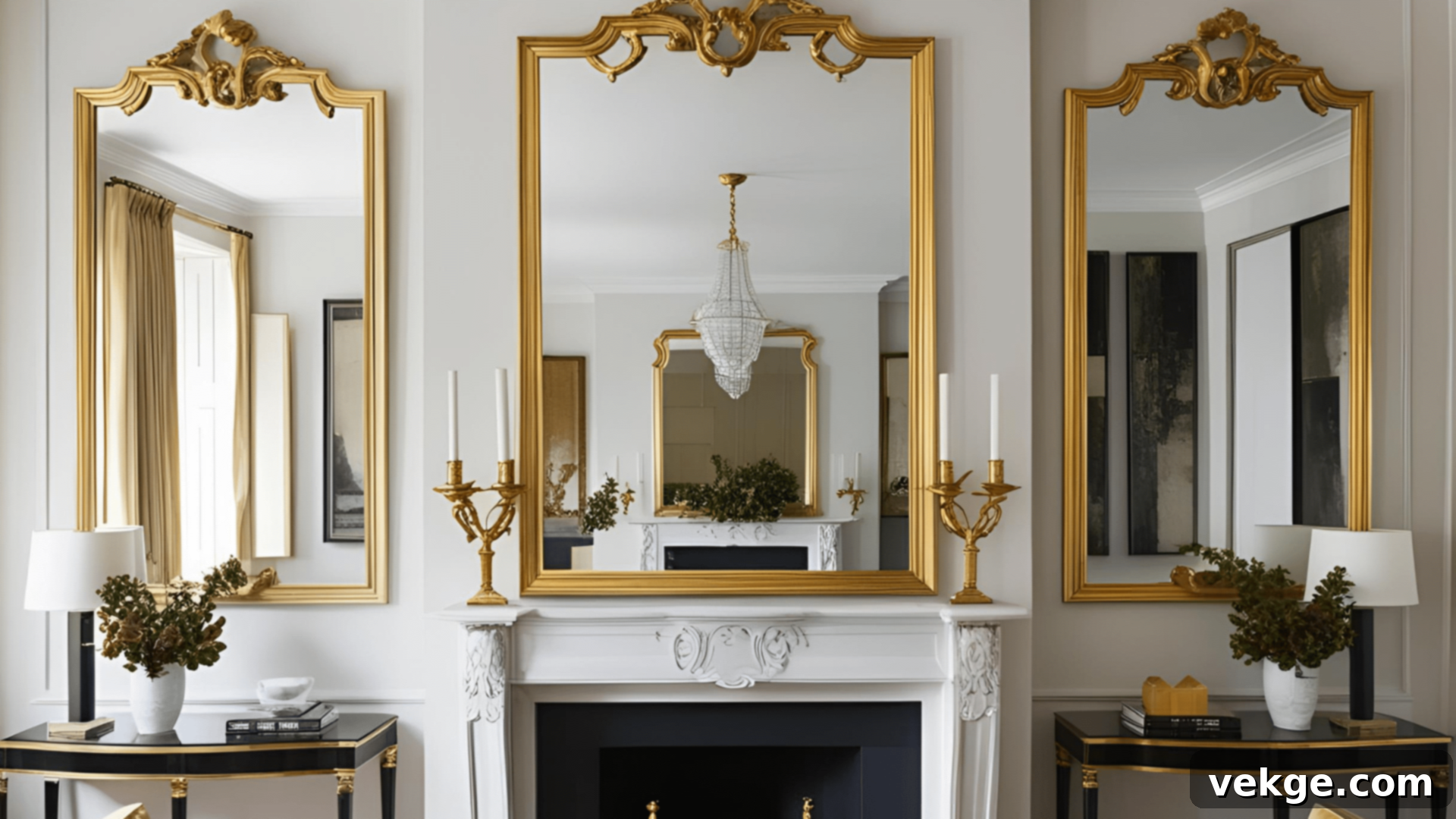
Large mirrors with elaborate gold frames are quintessential Baroque elements that translate beautifully into modern homes. Beyond their decorative appeal, they strategically reflect light, creating a brighter, more expansive feel and instantly infusing a space with luxury. Place them strategically above fireplaces, console tables, or in hallways for maximum visual impact.
Contemporary interpretations often feature frames with simpler lines, perhaps with just a subtle touch of carving or a refined antique gold finish, making them versatile enough to complement various modern aesthetics while still nodding to their historical roots.
Wall Treatments: Architectural Sophistication
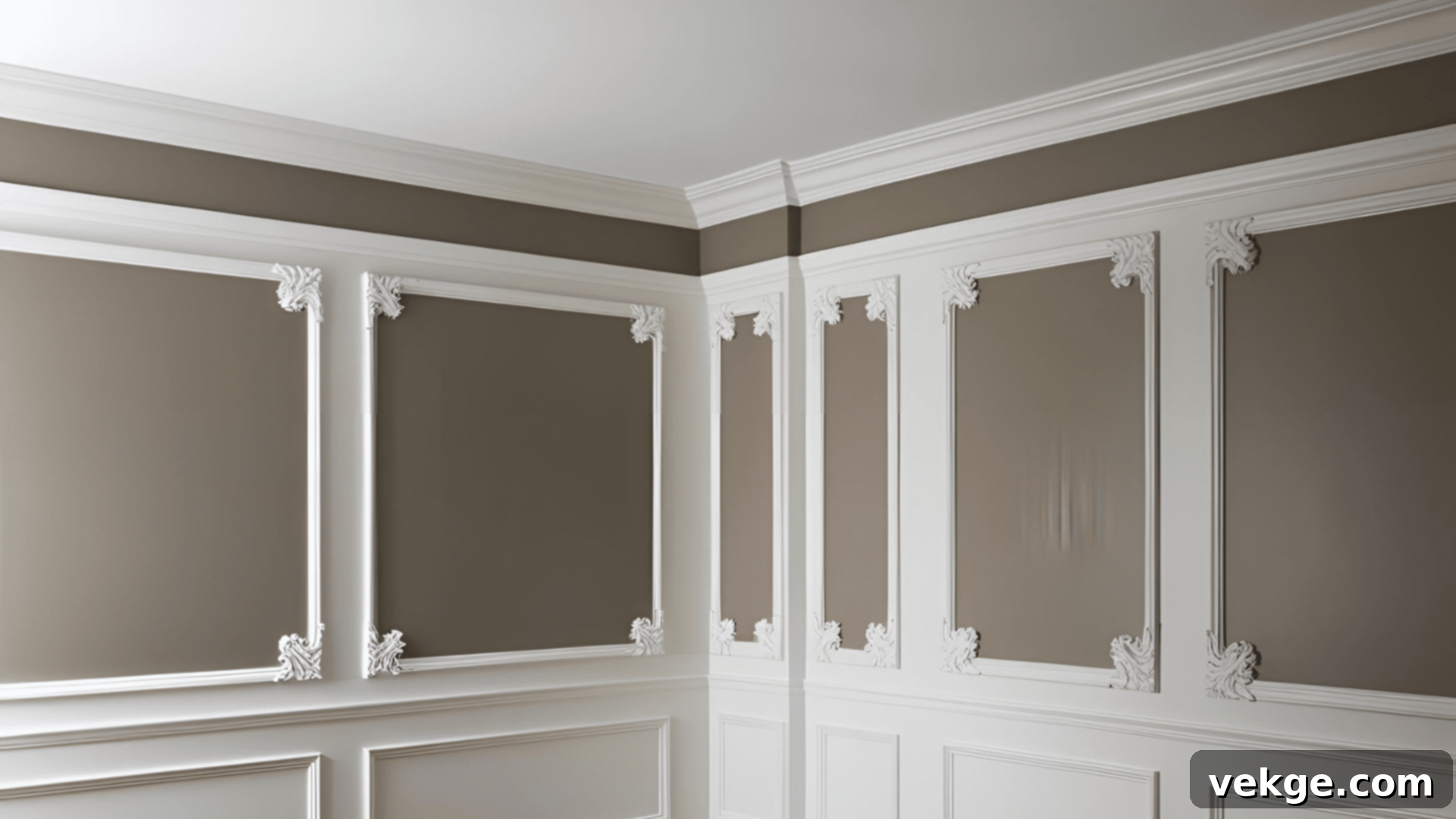
Detailed moldings, wainscoting, and wall panels are transformative elements that convert plain walls into features reminiscent of classic Baroque architecture. Adding chair rails, crown molding, or intricate picture frame detailing provides structure, formality, and a sense of bespoke craftsmanship to any room. These elements define spaces and add a layer of historical elegance.
For a sophisticated modern twist, consider painting all moldings and panels the same color as the wall. This monochromatic approach creates a subtle yet luxurious textured effect that maintains clean lines and a contemporary feel while still honoring the Baroque tradition of architectural ornamentation.
Rich Textiles: Tactile Luxury
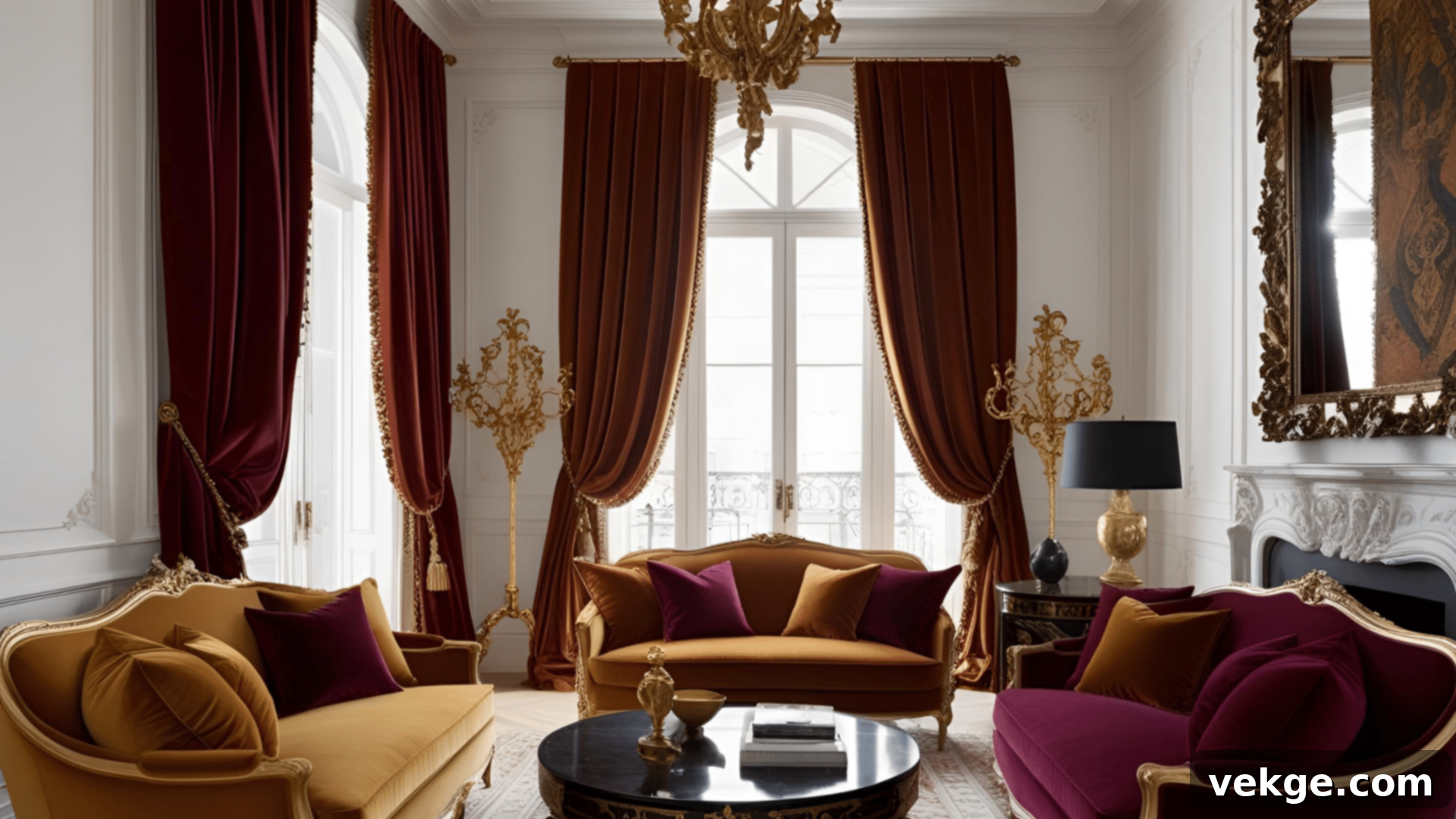
Plush velvet drapes, cushions, and upholstery are indispensable for introducing warmth, depth, and an undeniable sense of luxury into Modern Baroque spaces. These rich fabrics not only contribute vibrant color and sumptuous texture but also pay homage to the style’s historical roots, where textiles were paramount.
To keep the look fresh and current, gravitate towards deep, jewel-toned velvets or silks in simple, solid colors or subtle patterns rather than overly busy or traditional designs. This ensures the textiles feel sophisticated and refined, not dated, allowing their inherent richness to speak for itself.
Statement Art: Dramatic Focal Points
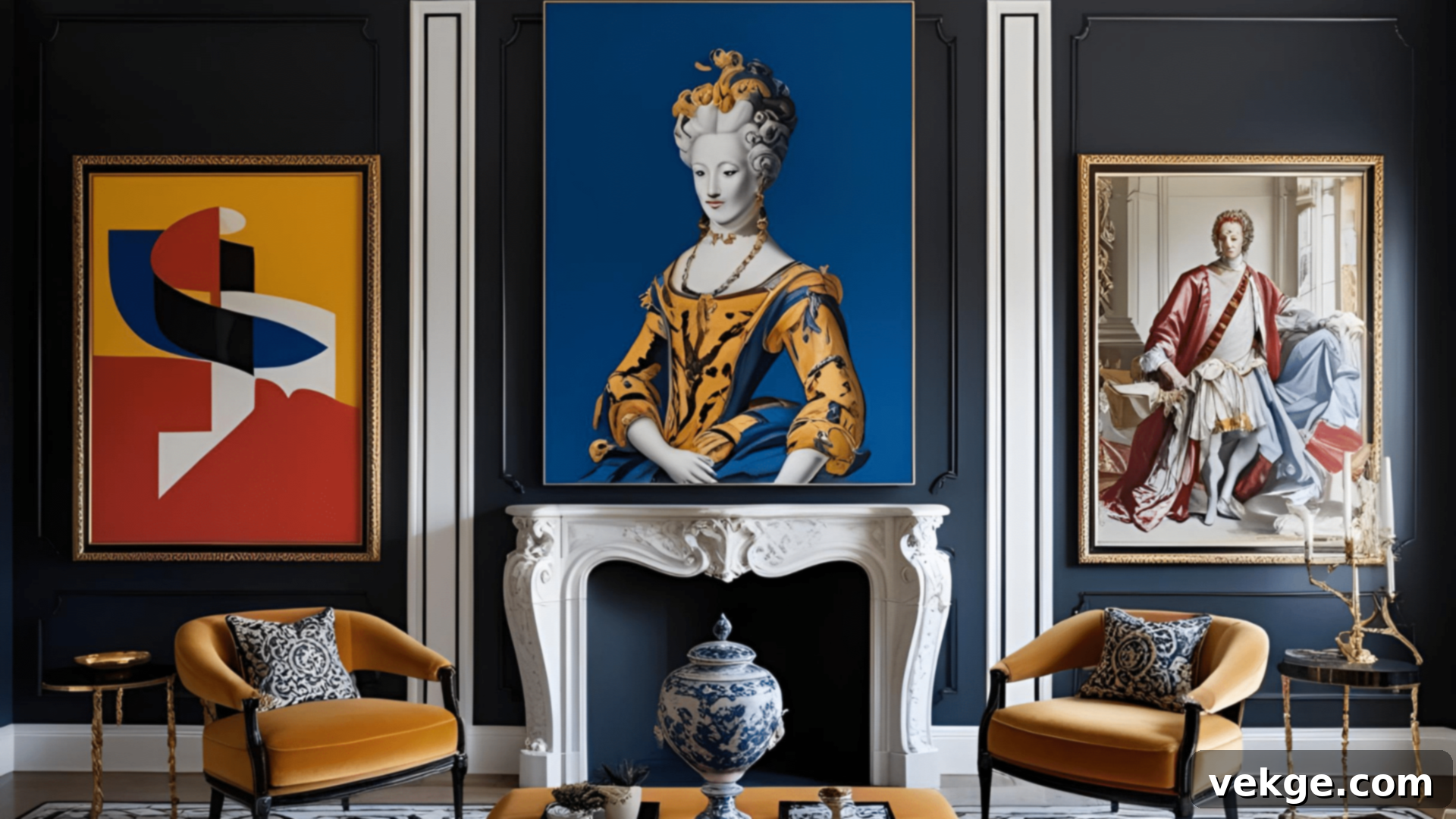
Large-scale artwork with bold colors and compelling subject matter connects directly to Baroque’s dramatic and theatrical origins. In modern spaces, this might translate to striking abstract pieces housed within ornate, gilded frames, or classic portraiture presented in sleek, minimalist borders. The contrast itself creates visual interest.
The key is to select pieces that possess significant visual weight and command attention, acting as a central focal point without feeling historically heavy or out of place. Art in Modern Baroque should be impactful and thought-provoking, contributing to the room’s narrative.
Sculptural Objects: Historical Charm, Modern Context
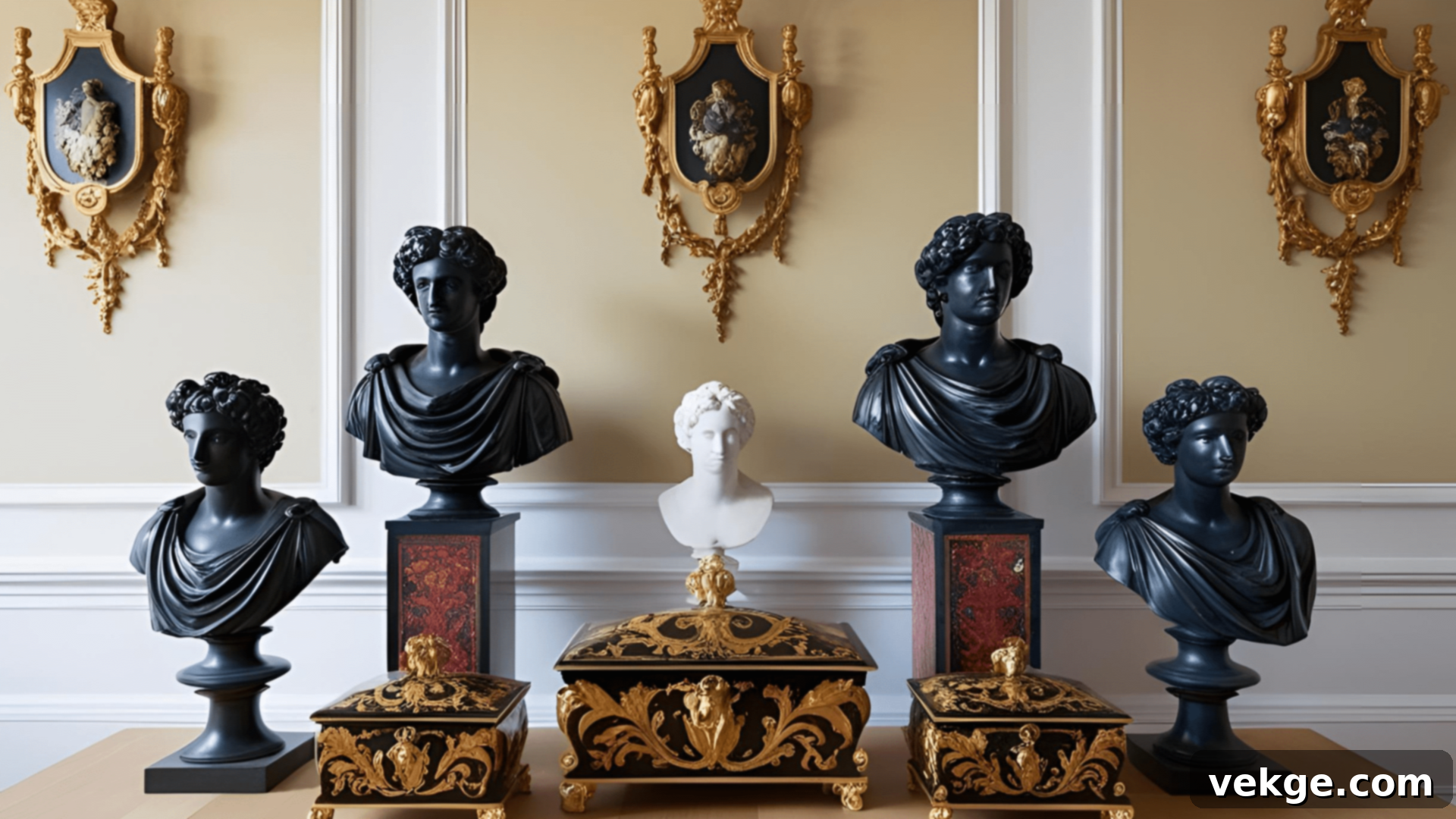
Three-dimensional decorative elements, such as classical busts, elegant figurines, or intricately designed ornate boxes, inject authentic Baroque character into a modern setting. These objects provide a tangible link to the past, adding depth and personality.
Modern interpretations might feature classical forms rendered in unexpected materials like polished chrome or bold, contemporary colors. These sculptural accents are most effective when given ample space to be admired individually, rather than being crowded among other items, allowing their unique form and historical resonance to truly stand out.
Mixed Metals: Contemporary Sparkle
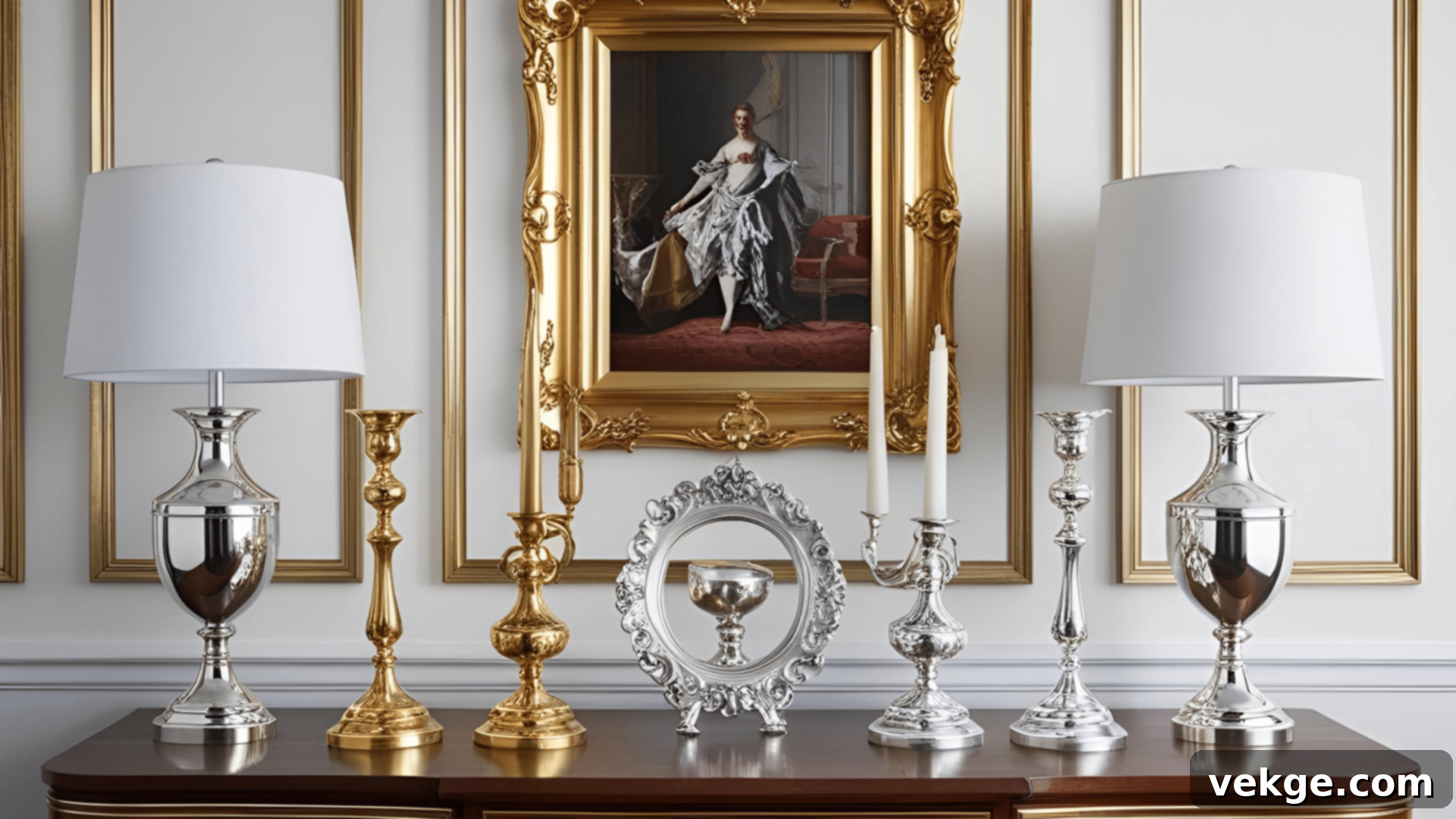
The strategic incorporation of gold and silver accents through picture frames, elegant candleholders, and various decorative objects introduces a vital sparkle and sheen to Modern Baroque rooms. These metallic touches are essential for reflecting light and adding a touch of glamour.
The contemporary approach often embraces mixing these metals—pairing brushed gold with polished silver, or antique brass with chrome—rather than rigidly matching every metallic element. This creates a more curated, layered, and less formal aesthetic, imparting a collected feel to the space.
Patterned Floors: Grounding Grandeur
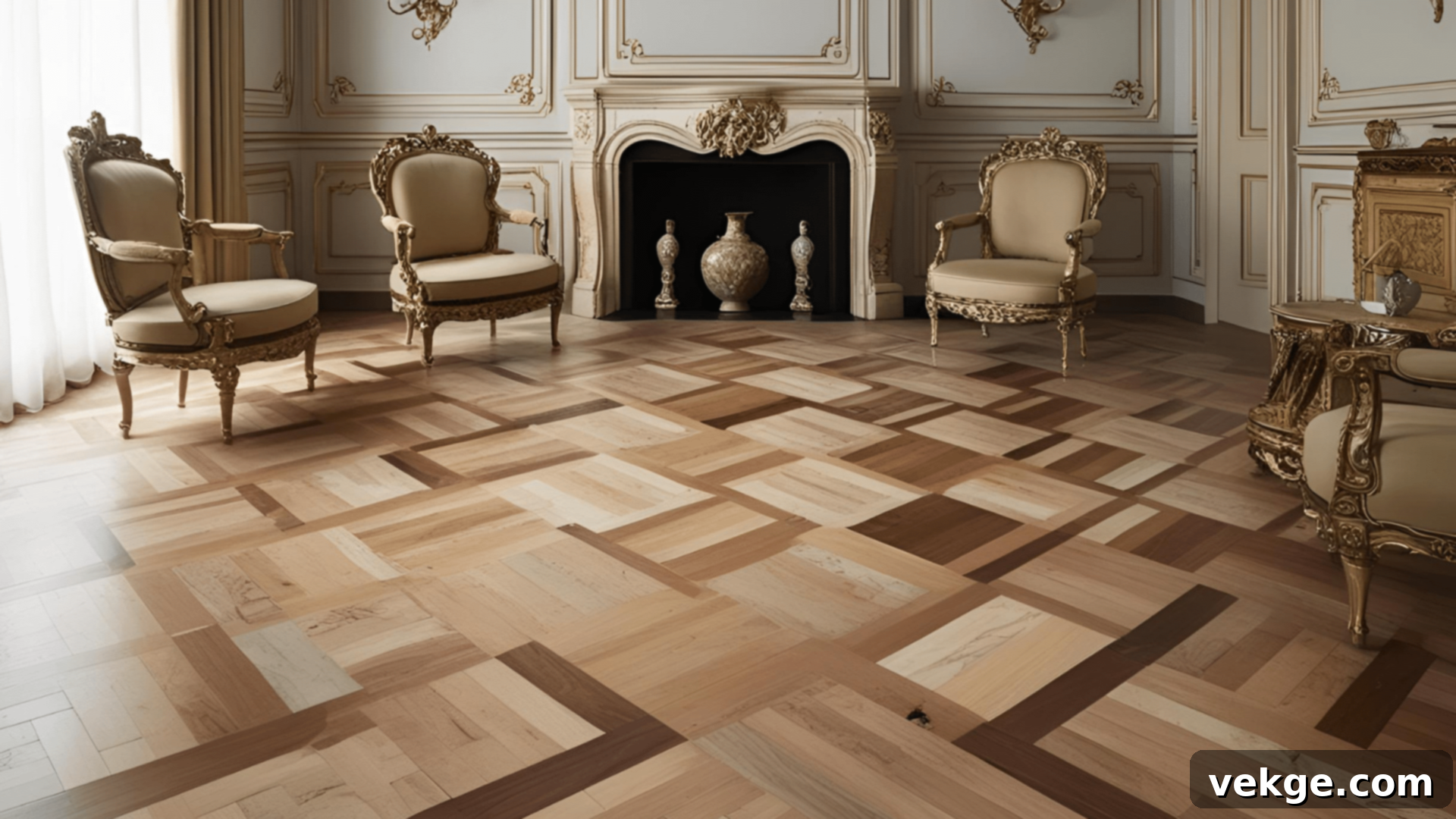
Elegant floors, such as marble with sophisticated geometric patterns or high-quality hardwood laid in a classic herringbone arrangement, perfectly honor the Baroque era’s meticulous attention to detail and craftsmanship. These flooring choices provide a grand foundation for the rest of the design elements.
In modern homes, achieving a similar effect without permanent structural changes can be done through the use of luxurious area rugs. Opt for rugs featuring subtle damask, geometric, or abstract patterns in complementary colors to define spaces and introduce that characteristic Baroque grandeur underfoot.
Crystal Accents: Refined Brilliance
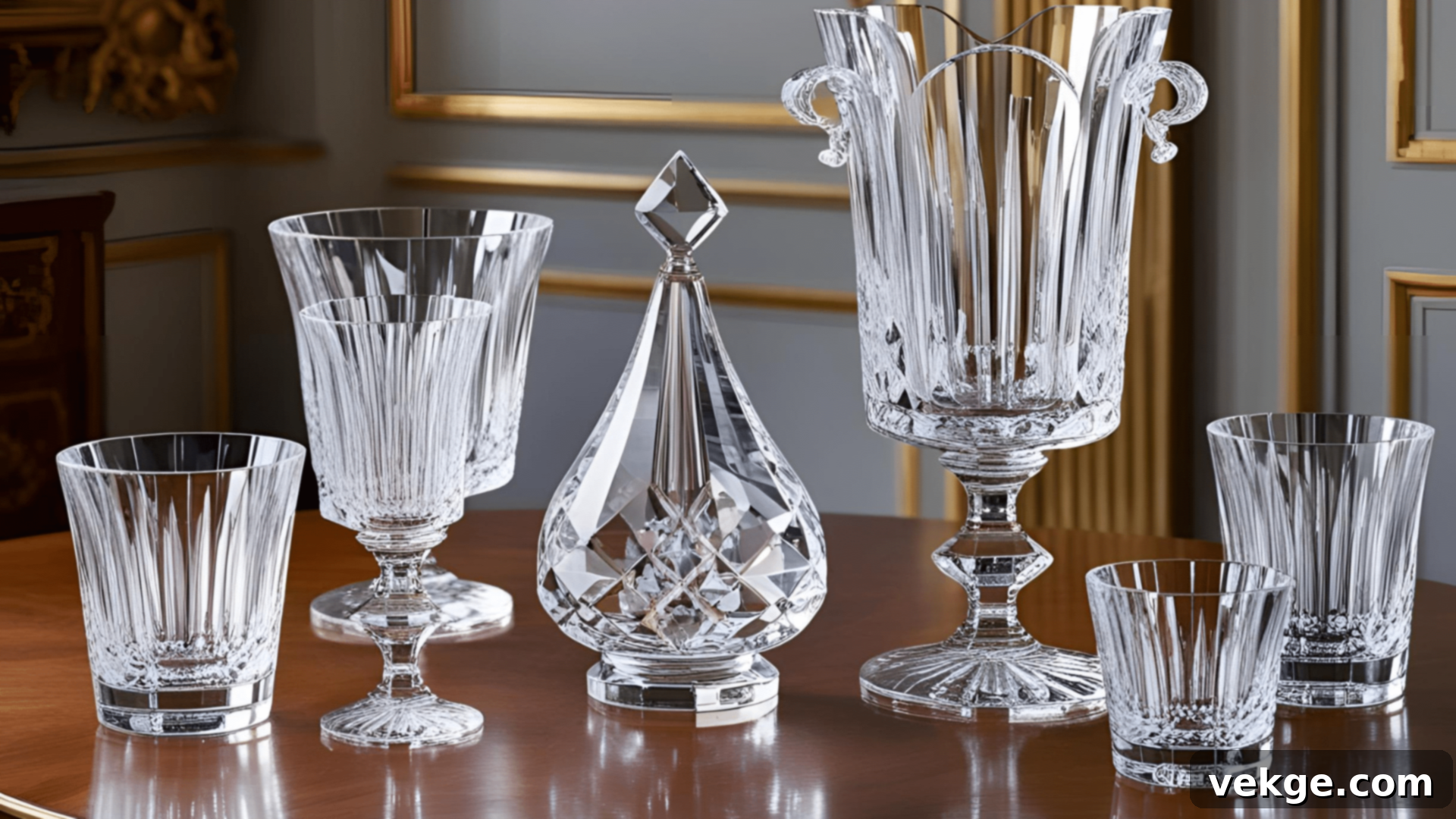
Exquisite cut crystal items are key to catching and reflecting light, adding the signature sparkle and brilliance so closely associated with opulent Baroque interiors. These elements introduce a delicate yet dazzling touch of luxury.
Today’s approach to crystal accents favors fewer, larger, and more impactful pieces—such as a substantial crystal vase or a pair of elegant crystal decanters—rather than numerous small, clustered objects. This strategy maintains a clean, focused aesthetic while preserving the inherent shine and undeniable allure of crystal in a contemporary setting.
Common Mistakes to Avoid in Modern Baroque Interior Design
While the allure of Modern Baroque is undeniable, there are common pitfalls that can detract from its sophisticated charm. Being aware of these mistakes can help you create a truly harmonious and luxurious space.
- Over-ornamentation: Crowding too many ornate pieces together often leads to a chaotic and overwhelming look, rather than an elegant, curated space. Instead, choose a select few key decorative items or furniture pieces and give them ample room to breathe and stand out as individual statements.
- Excessive Darkness: Relying solely on deep, dark colors without adequate contrast can make rooms feel small, gloomy, and uninviting. To prevent this, always balance rich, saturated tones with lighter neutrals (like soft whites, warm greys, or creams) to ensure spaces remain open, airy, and fresh, allowing light to circulate.
- Using Cheap Imitations: Investing in inexpensive copies of Baroque furniture or decor can significantly diminish a room’s overall quality and authenticity. These pieces often look fake and lack the craftsmanship that defines true Baroque style. It is always better to save for one authentic, high-quality statement piece than to fill a room with many poor imitations.
- Inadequate Lighting: Poor lighting choices can completely ruin the intended effect of luxurious Baroque elements, leaving them looking dull and flat. Modern Baroque interiors demand multiple light sources strategically placed at varying heights to properly highlight textures, intricate details, and create dramatic shadows and highlights.
- Pattern Overload: Mixing too many bold or competing patterns in one space can lead to visual confusion and a restless atmosphere. For a more cohesive and sophisticated look, limit prominent patterns to one or two key items within a room, allowing them to be the stars while other elements remain simpler.
- Neglecting Comfort and Functionality: While aesthetics are crucial, forgetting about the practical aspects of living can result in rooms that look stunning but feel unwelcoming. Ensure that seating is genuinely comfortable, and that the layout and flow of the space are practical for daily life. A truly luxurious home is both beautiful and functional.
- Imbalance of Old and New: Failing to strike the right balance between historical Baroque elements and contemporary pieces can make rooms resemble museum exhibits rather than livable homes. The most successful Modern Baroque spaces expertly blend timeless historical touches with clean, sleek contemporary furniture and decor, creating a dynamic and inviting dialogue between eras.
Conclusion
Modern Baroque interior design presents an extraordinary opportunity to infuse today’s homes with unparalleled luxury, drama, and historical richness, all while maintaining a refined sense of balance. By thoughtfully combining rich color palettes, sumptuous fabrics, and intricately detailed furniture with clean, modern pieces, you can curate spaces that feel both uniquely special and wonderfully livable.
The core principle to remember is balance—a strategic integration where approximately one-third Baroque elements complement two-thirds modern pieces serves as an excellent guiding rule. Prioritize quality over quantity, choosing impactful, well-crafted items that truly embody the spirit of the style. Leverage sophisticated lighting techniques to sculpt the perfect mood and highlight architectural details, transforming your interiors throughout the day.
Above all, never forget that comfort and functionality are as vital as style. A Modern Baroque home should not only be a feast for the eyes but also a sanctuary that caters to contemporary living. By embracing these essential tips, you are well-equipped to create a home that elegantly honors this grand historical style while being perfectly adapted to the demands and aesthetics of modern life.
